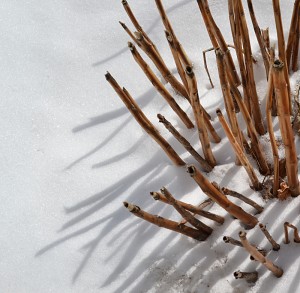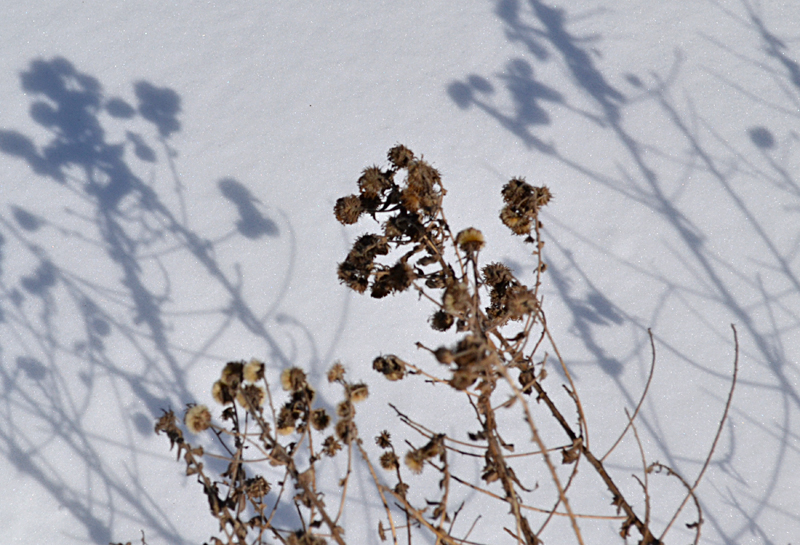
by Connie Oswald Stofko
This has been one bitterly cold winter.
On the plus side, it has been snowy.
You may think the cold and snow combine to create a double whammy, but when it comes to our gardens in Western New York, it would have been worse without the snow.
“If you see snow, you should be happy,” said Carol Ann Harlos, Master Gardener coordinator for the Erie County Cornell Cooperative Extension.
The air temperature and soil temperature can be very different. The air temperature might be 2 degrees below zero Fahrenheit, but the snow can act as insulation, keeping the soil warmer, Harlos explained.
Besides cold temperatures, strong winds can be a problem during winter because the wind desiccates the soil; that is, it pulls the moisture out of the soil. However, the snow cover protects the soil from the wind, too. And when the snow melts, it adds water to the water table.
“The snow is a good thing,” Harlos said. “If plants are properly planted, they should do okay this winter.”
This is an average winter for Western New York
While this winter has been cold compared to the last two years, it’s still within range for our region. Most of Western New York is in Zone 6, and the average minimum air temperature for that zone is between 0 degrees and -10 degrees Fahrenheit, she said. That’s what we’ve been experiencing this winter.

Harlos pointed out that those are averages, and we have to remember what an average is. You take your temperatures, add them together, then divide by the number of temperatures. Even if your garden dipped to -11 degrees one night, the average minimum temperature for the winter would still be within the range for the zone.
Not sure of your gardening zone in Western New York? Find out here.
The other thing that confuses people is weather and climate, Harlos said. They might look at the cold temperatures this winter and think that this is evidence that we’re not experiencing global warming, but that’s incorrect.
“Global warming is a bad term because it makes people think that everything is getting warmer,” she said.
Overall, the world’s temperatures are higher. This is happening in other parts of the world and it’s happening in Western New York, too. That is why most of Western New York was changed from Zone 5 to the warmer Zone 6. It reflects the overall warmer temperatures we are experiencing here. But that doesn’t mean that temperatures are warmer on a daily basis.
Weather is what happens from day to day. Climate is what happens over years and decades. Our climate is getting warmer, but it doesn’t mean we won’t have cold days. The weather Western New York is having now is actually typical for our climate, but because the last two winters have been mild, we might think that only mild winters are normal.
“Human beings tend to remember the last thing they experienced,” Harlos said.
And while Western New York and much of the United States is experiencing cold weather right now, much of the rest of the world is experiencing extremely hot weather right now, she pointed out.
“Be careful not to take your own personal experience and generalize it worldwide,” she cautioned. “You have to look at the total effects, not the local weather.”
What you can do to help plants survive winter

The key to helping ensure that your perennials survive the winter is to plant them correctly, Harlos said.
If you’re looking for something you can do now, it’s probably too late. One exception is if a plant is heaving up out of the ground. If you find that happening, stomp down the plant to get it back in place. Then take a bag of soil and pour it over the whole plant. These may sound like desperate measures, but you’re trying to save the plant, Harlos said.
In the future, use these planting tips to help perennials survive the winter:
- Water in the autumn. If the roots of the plant are moist in autumn, they will continue to grow and help the plant to become well established. Even though her garden got some rain this autumn, Harlos still watered occasionally. In addition, “Wet soil helps retain the heat, which people don’t seem to know,” Harlos said.
- Use organically rich soil. Perennials will overwinter better in soil with compost because it absorbs moisture better, she said. Harlos said that because she uses compost, she never has to fertilize her garden.
- If you do fertilize, don’t use nitrogen in late autumn. She said that plants don’t overwinter well if you use fertilizer containing nitrogen compounds late in autumn.
- Spider out the roots. When you plant a perennial, don’t leave the roots in a tight ball. Spread the roots out or spider them in order to help them penetrate the soil better.
- Add mulch around the plant in autumn. The mulch will protect the roots, especially if we get a winter with little snow cover.
- Choose the right spot. Read the plant tag or ask the folks at your local garden center what kind of conditions are best for the plant. “Ninety-five percent of all problems with plants are cultural,” Harlos said. “That’s a polite way of blaming the gardener.”
Bugs won’t be affected by the cold weather

The Master Gardeners have been getting questions about how this cold weather will affect bugs. Gardeners are hoping that the number of pests will decline.
“In spite of everybody’s hopes, most insects will be just fine,” Harlos said.
Many insects, such as Japanese beetles, burrow deep enough into the ground that the bitter air temperatures don’t bother them. The caterpillars known as wooly bears can freeze solid and then defrost without any damage to their cells. The bugs around here have adapted to our climate and have ways of dealing with winter.
One insect Harlos is concerned about is the honey bee, which was brought over from Europe and is used to pollinate crops and for honey. The way honey bees deal with the cold is by gathering together in a ball. The individuals constantly change position. The ones on the outside move to the inside of the ball to get warm and the ones on the inside take their turns on the colder outer part of the ball. The problem is that in extremely low temperatures, the bees on the outside of the huddle can get so cold that they can’t move and they die of starvation even though there’s plenty of honey in the hive. Let’s hope that bee keepers can manage to maintain healthy hives through this cold weather.
Have more gardening questions?
If you’ve got questions about your plants and garden, contact the Master Gardeners at Cornell Cooperative Extension. They’d be happy to help.



Winter two years ago was not very good for plants here with frost heave. This year has been wonderful because it has been almost constant snow cover. I just hope it does have an end in sight though.
You are welcome Conie! I will see if they want a photo and let you know.
Thank you for allowing this Conie!
Fredi
Sally, thanks so much. Carol Ann Harlos had a lot of great tips.
I love taking photos in the winter. There is a lot of beauty in the winter, too, especially in the snow.
Fredi, I would be thrilled if you mentioned Buffalo-NiagaraGardening.com in your column! That is a very generous offer.
The last day to enter the contest is Tuesday, April 1. Let me know if you need any other information or a photo or anything.
Thanks so much for your kind words. You’ve made my day!
A very informative posting -lots of great information! Connie, your winter photos are wonderful and illustrate just how beautiful those spent perennials can be in winter!
Sally
Hi Conie,
May I mention your online mag and the contest in my weekly newspaper column? Next week, March 12, would be the first time it would be out.
I don’t know how long it runs.
Great mag – better and better all the time!
Fredi